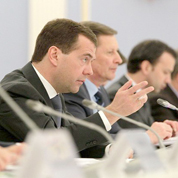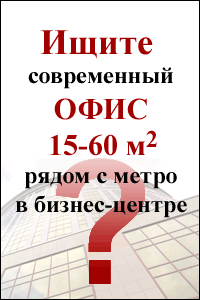Omnipresence of Russian corruption highlights its invincibility under Medvedev

Last month, President Medvedev took another attempt, evidently his last as the head of state, to rein in Russia’s rampant corruption by signing a new National Anti-Corruption Plan that will now be implemented by the president-elect.
By signing a new plan at the end of his term, the lame dock president has conceded defeat in his fight against this aggressively growing social, political and economic evil, which has become the nation’s biggest problem, having displaced the nation’s traditional perennial problems of ‘abundance of fools and bad roads.’
To be fair, it needs to be noted that the latest plan, like those before it, contains the right words with the appropriate accent and other vital power attributes that indicate Kremlin’s serious intention to fight corruption. The plan also includes a number of novelties and innovative measures such as the use of electronic gadgets. All this is aimed at ensuring a stricter control over all Russian bureaucrats’ revenues and expenses as well as those of their immediate family members that are usually the ‘formal beneficiaries’ of their high-ranking relatives’ multimillion assets embezzled or gotten through pseudo-legal means.
Moreover, all properties acquired illegally or via unverified revenues, whose worth will exceed bureaucrats’ total incomes from their principal jobs over the past three years will be confiscated in favor of the state. If forensic audit confirms the illegal or criminal origins of such revenues, then such officials will be dismissed and legal prosecutions initiated against them. Anyone, including political parties and media can initiate such audit of revenues and expenses. The main advantages of this anti-corruption document, which at the same time, are also its major disadvantages, are its arrays of new measures. One would wonder why such measures were conspicuously absent in the past, despite their necessity. This reflects the national specificity, a sort of unique innovative know-how, of the Kremlin’s anti-corruption strategy, and hence, its failure.
However, it is surprising that the new strategy authors, just like their predecessors, like doctors treating chronic patients, also recommend palliative or symptomatic methods to fight corruption, instead of using radical surgery to eliminate all the underlying factors that nurture this evil in Russia. This means fighting the economic, traditional, social and political factors, instead attacking their negative consequences, even though this is also important. Therefore, the focus must be placed on ways to prevent illegal self-enrichment by public officials at the earliest stage, instead of taking steps to fight them after their misappropriation of government funds.
In this context, for the new plan to be really effective, it must address, first of all, all the traditional non-transparent patterns of solving problems in this society via relatives, friends, acquaintances, etc. Others include eradication of legal nihilism among citizens, criminal actions, and most importantly, deliberate non-performance of official duties by bureaucrats, absolute helplessness of certain categories of citizens in the face of blatant lawlessness prevalent in most state institutions, etc.
All these shortcomings serve as a ‘fertile ground’ for corruption to flourish in all its glory in all areas of state services such as getting passports, driver licenses, placing children in educational institutions, etc. For businesses, these include, but not limited to, frequent, and sometimes, unjustifiable checks, from the police, tax inspectors, fire safety agency. Others includes such instances as securing permits, for example, during customs clearance of cargos, participation in state tenders and contracts, distribution of quotas, etc. Russian corruption is distinguished by the fact that bureaucrats, usually middle-ranked ones, who apply for state services in other government agencies outside their jurisdictions, also succumb to bribery, just like all citizens. In the most flagrant cases, these officials even secure their services from counterparts on a barter basis via the principle, ‘you scratch my back, and I scratch yours.’ In addition, gaping legal loopholes creating a fertile soil for corruption are inherent parts of almost all the new bills under consideration, another boon for corrupt bureaucrats.
Moreover, law enforcement and other state agencies are often put in charge of the implementation of anti-corruption laws, even though they are the direct subjects of their control. It is easy to understand that under such circumstances the state’s national interests often run counter to the personal, corporate and departmental interests of the high-ranking ‘light-fingered officials’ working in such agencies. Such arrangement, according to the well-known local proverb, always absolutely ‘waters down’ the severity of Russia’s anti-corruption legislations. Therefore, it is clear why corruption, despite the copious programs and loud statements from the Kremlin, White House, Federation Council and State Duma, is not going down, but growing stronger with each passing year. Indeed, corruption has gradually become institutionalized, or even legalized, in some cases.
The phrase, ‘legalization of corruption schemes,’ brings to mind the president’s order on laying down the parameters for legalizing ‘lobbyism institution’ in Russia by December 1. This fashionable term, ‘lobbyism,’ is already widely used in Russia in a distorted format that has long earned it a negative neologistic tag, ‘corrupt lobbyism, Russian style.’ Fighting corruption and legalizing lobbyism is typically a Russian modus operandi, because on one hand, the government is haranguing corrupt officials, but granting them reliable lifebelts on the other. That is why experts are so skeptical, saying blind copying of this foreign practice on institutionalization of lobbyism, just like the foreign traditions and economic models borrowed from Europe and the United States in the early post-perestroika period, is a road to a deadend.
To counteract this point of view, Kremlin policy strategists have passionately argued that there is a huge difference between ‘lobbyism’ and ‘corruption,’ citing the United States and EU states as exemplary examples, where such institutions are positively serving the needs of the state, businesses and society in general. However, they have, purposely or accidentally, forgotten to equally note that these countries have long implemented very strict, and most importantly, efficient anti-corruption programs, which enable them to fight against corruption, even beyond their geographical borders. The same, however, cannot be said of Russia, where the launch of such programs is still at the deliberation stage.
Therefore, there is a need to remind the Kremlin strategists that the difference between ‘lobbyism’ and ‘corruption’ is similar to the one between a ‘poison’ and a ‘tablet.’ Anyone, with at least basic knowledge of organic chemistry from high school, not to mention pharmacology, will concede that this difference is highly relative. In fact, any harmless pill, for example, aspirin, can become a highly dangerous poison in unskilled hands, with the associated negative consequences. The same is true for ‘lobbyism’ and ‘corruption.’ So, if the law on lobbyism is forced down the throat of legislators, or more aptly in our case, seriously “lobbied” by interested influential circles, it will absolutely be disconnected with the Russian reality, and thus, bring much more harm than good, as it will only serve the interests of influential elite in the nation’s political and business circles, rather than the public interests.
Therefore, when planning really effective measures to fight corruption, those tasked with the preparation of such measures must take into account the multifaceted diversities and sophisticated intricacies of the officials engaged in corruption. In other words, the plan must fight such pseudo-legal ways of self-enrichment as subornation, expensive gifts as masked corruption, all kinds of disguised pilfering of state funds and other corruption schemes used by bureaucrats or those close to them that are often referred to as ‘mediators of corruption schemes.’
Such a total approach against corruption, by the way, is taken from successful international experience of fighting this social and economic problem in modern world. Therefore, contrary to its traditions, Russia does not need to reinvent the wheel, but thoroughly analyze the efficient practices accumulated over the years by highly developed countries and such authoritative international agencies as the World Bank, International Monetary Fund and other respectable international institutions on how to successfully conquer this evil that has eaten far deep into the core of the Russian society. It is the very imperative that Russia must fully adapt this global experience to its local need by taking into consideration the specific local realities and the uniqueness of its citizen’s mentality and traditions.
This is the only way for Russia to develop long-term sustainable immunity against this malignant tumor, whose highly contagious and incurable metastases have long contaminated the entire country, its political and economic management structures. Otherwise, any good intentions on the part of the Kremlin will, according to Victor Chernomyrdin, end the same way that most state initiatives always do in Russia. That is when bureaucrats want to make life easier for common people, but always fail to deliver on their promises. In other words, if the state intentions fail, ordinary people will be on the receiving end, whilst the bureaucrats, as usual, will be better off.












 Web design,
Web design,